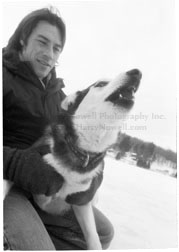Exposed! :: People Pictures - Portrait Photography ::© Copyright 2007. All Rights Reserved. Contents
I recently judged a city-wide photography competition involving four camera clubs and hundreds of pictures. It always amazes me to see the vast diversity and interpretations of a subject. Ask for a "portrait" and photographers produce many types of people-pictures from the "highly structured" in the studio to the "carefree candid" from the park. As with any photography there is no right way to take the picture. To develop as a portrait photographer, though, requires you to explore the many possibilities! In this edition of Exposed! we investigate the idea of portraits - just in time for the summer shooting season! What is a Portrait?Many people believe a portrait to be a formal, posed photograph done in a studio with powerful strobes and a backdrop. And they are right - that is one type of portrait. But there are other endless options for portraiture! A portrait can be:
A portrait is a representation of someone - it is a people picture!
Style, Baby!As discussed portraits can be many things to many people. This can be described as photographic style or "How you use your equipment to create your interpretation of the person." Style is personal. Developing your style takes time! Study other work, critique and practice, practice, practice! Renowned Canadian portrait photographer Yousuf Karsh spent years developing his craft! Style develops as you recognize your visual preferences and practice with different photographic techniques. The best way to get better people pictures is to:
Portrait EquipmentOptions for capturing the portrait have never been greater. You can choose:
Each choice will have different equipment implications! Too often people are overcome with the choices. Chances are, if you have a camera, you can produce a good portrait! Don't worry about your equipment - the success of the portrait lies within you - the photographer. The Neglected Subject!What am I talking about - "the neglected subject?" All too often on my portrait courses people are so consumed with their equipment and style decisions they often abandon the most important part of their picture - their subject! You must recognize your subject as the centrepiece of the portrait and, as such, interact with them! Even if you are doing a street portrait of an unknown person your presence will affect the outcome. In portrait photography your job is to interpret that person with the assistance of your camera. You have to draw from them what you need. It is not enough to ask them smile - you must MAKE them smile. Your interaction with the subject can be crucial to the effectiveness of the portrait! In the portrait, above, I had to show the fun and bond between the man and his dog - enticing the pup to howl was an important part of my job! HomeworkThis month your job has more to do with managing people than it does with cameras! You cannot tell your subject what your homework assignment is - other than you must photograph portraits. Turn your camera to fully automatic - not something I usually suggest! Let the camera do the technical work. Concentrate on the person. Your job is to draw the following emotions from your subject simply by interacting with them. Ahem: "You cannot ask them to smile - you must make them smile!"
You may need to tell them a joke, tell them a story, or ask them to tell YOU a story! As you talk, watch your subject and be ready to release the shutter when the magic smile appears. Be attentive. Be quick. The smile will vanish as quickly as it appeared. You should end up with a range of emotions in your pictures. They should be true emotions rather than cheesy smiles. Learning to interact with your subject and draw emotion will make you a better portrait photographer! Pro PerspectivePortraits are a balancing act. I must:
... all seemingly at the same time. It's hard work. But it's fun! With practice it gets easier. Final FramePortrait photography is a fun challenge especially with summer barbecues, the cottage and other opportunities for portraiture right round the corner! Still need some help with portraits? Consider my Natural Light Portraits Workshop coming soon. Take photos. Have fun! |
Samples |

